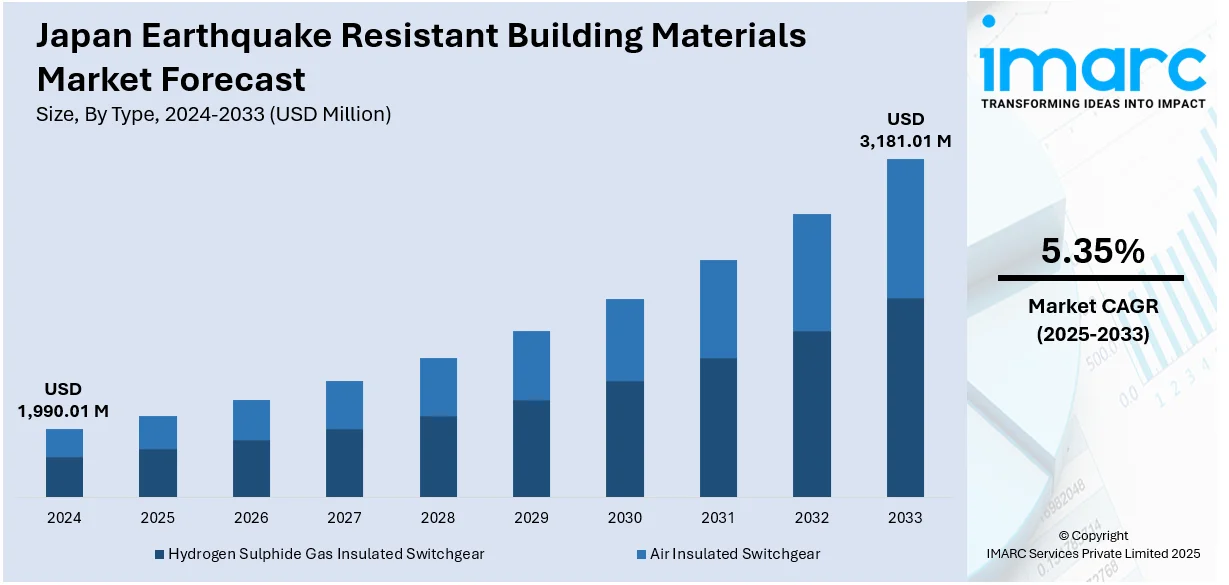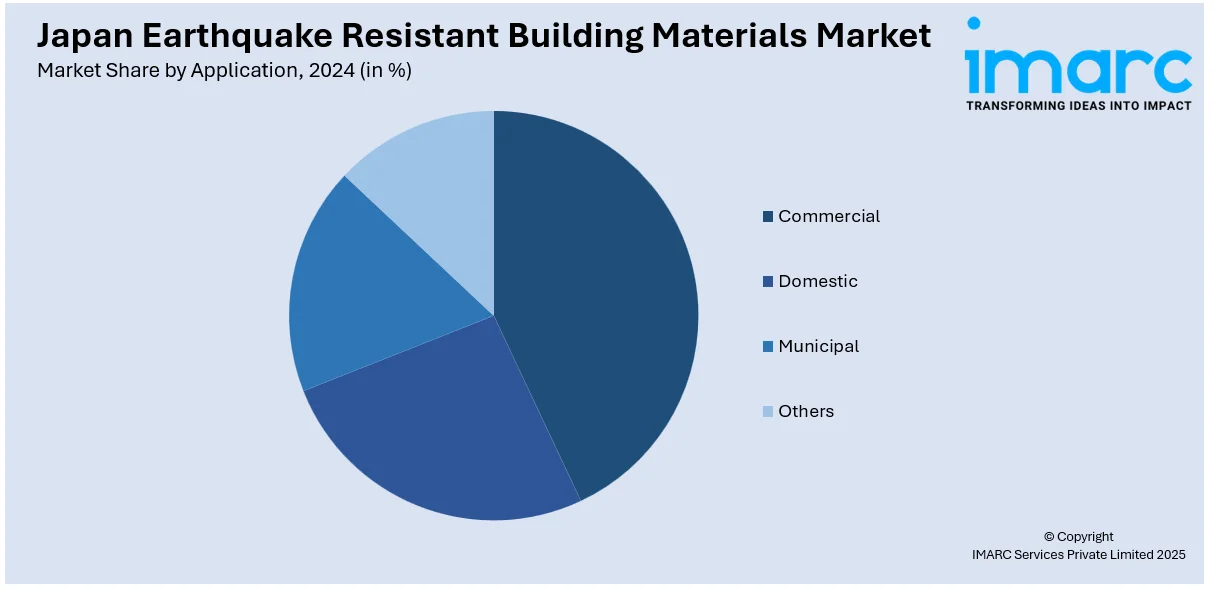
Japan Earthquake Resistant Building Materials Market Size, Share, Trends and Forecast by Type, Application, and Region, 2025-2033
Japan Earthquake Resistant Building Materials Market Overview:
The Japan earthquake resistant building materials market size reached USD 1,990.01 Million in 2024. Looking forward, IMARC Group expects the market to reach USD 3,181.01 Million by 2033, exhibiting a growth rate (CAGR) of 5.35% during 2025-2033. At present, rising seismic activities are enabling the stringent implementation of building codes and regulations that prioritize the utilization of materials capable of withstanding tremors. Besides this, the growing investments in research and development (R&D) activities are contributing to the expansion of the Japan earthquake resistant building materials market share.
|
Report Attribute
|
Key Statistics
|
|---|---|
|
Base Year
|
2024
|
|
Forecast Years
|
2025-2033
|
|
Historical Years
|
2019-2024
|
| Market Size in 2024 | USD 1,990.01 Million |
| Market Forecast in 2033 | USD 3,181.01 Million |
| Market Growth Rate 2025-2033 | 5.35% |
Japan Earthquake Resistant Building Materials Market Trends:
Frequent seismic activity
Frequent seismic activity is positively influencing the market in Japan. The country experiences numerous earthquakes each year due to its location along the Pacific Ring of Fire, which creates constant awareness about seismic risks among builders, residents, and policymakers. As per industry reports, from 2014 to 2024, there were 10118 earthquakes measuring four or higher that occurred within 300 km (186 mi) of Japan. This ongoing threat leads to the stringent implementation of building codes and regulations that prioritize the use of materials capable of withstanding seismic forces. Consequently, companies are seeking innovative, durable, and flexible materials that can absorb and dissipate energy during earthquakes. Materials, such as shock-absorbing concrete, flexible steel reinforcements, and seismic dampers, are becoming essential in both new constructions and retrofitting existing structures. Public and private sector investments in infrastructure safety are driving the demand for these materials. Educational campaigns and real-life earthquake experiences are also generating public awareness, creating the need for safer housing and buildings. The market is also growing, as engineers and manufacturers are collaborating to develop advanced materials tailored to Japan’s seismic conditions. Additionally, insurance companies may offer incentives for earthquake-resistant buildings, motivating property owners to wager on better materials.

Rising infrastructure investments
Increasing investments in construction projects are impelling the Japan earthquake resistant building materials market growth. According to the IMARC Group, the Japan construction market size reached USD 625.4 Billion in 2024. As the government and private sector are allocating more funds to modernizing and expanding infrastructure, the demand for high-quality earthquake-resistant materials continues to rise. New construction projects, including bridges, railways, residential complexes, and commercial buildings, are adopting advanced materials that enhance structural resilience during seismic events. With Japan’s vulnerability to frequent earthquakes, these investments focus not only on expansion but also on safety and durability. Public infrastructure, such as hospitals, schools, and transportation hubs, receives upgrades with reinforced materials that meet strict seismic standards. Developers and contractors prefer using shock-absorbing concrete, reinforced steel, and seismic isolation systems to comply with regulations and ensure long-term structural safety. This trend is also promoting innovations, as manufacturers are spending resources on R&D activities to create materials that offer better performance under seismic stress. Additionally, rising urbanization activities are supporting the growth of earthquake-resistant building practices, especially in densely populated areas. These investments reflect a broader national focus on disaster preparedness and sustainability.
Japan Earthquake Resistant Building Materials Market Segmentation:
IMARC Group provides an analysis of the key trends in each segment of the market, along with forecasts at the country and regional levels for 2025-2033. Our report has categorized the market based on type and application.
Type Insights:
- Hydrogen Sulfide Gas Insulated Switchgear
- Air Insulated Switchgear
The report has provided a detailed breakup and analysis of the market based on the type. This includes hydrogen sulfide gas insulated switchgear and air insulated switchgear.
Application Insights:

- Commercial
- Domestic
- Municipal
- Others
A detailed breakup and analysis of the market based on the application have also been provided in the report. This includes commercial, domestic, municipal, and others.
Regional Insights:
- Kanto Region
- Kansai/Kinki Region
- Central/ Chubu Region
- Kyushu-Okinawa Region
- Tohoku Region
- Chugoku Region
- Hokkaido Region
- Shikoku Region
The report has also provided a comprehensive analysis of all the major regional markets, which include Kanto Region, Kansai/Kinki Region, Central/Chubu Region, Kyushu-Okinawa Region, Tohoku Region, Chugoku Region, Hokkaido Region, and Shikoku Region.
Competitive Landscape:
The market research report has also provided a comprehensive analysis of the competitive landscape. Competitive analysis such as market structure, key player positioning, top winning strategies, competitive dashboard, and company evaluation quadrant has been covered in the report. Also, detailed profiles of all major companies have been provided.
Japan Earthquake Resistant Building Materials Market News:
- In October 2024, Aster Co., Ltd., the prominent Japanese startup, created a novel material that, when easily used as a coating on masonry surfaces, greatly enhanced their resistance to earthquakes. The product was created by SUZUKI Masaomi and YAMAMOTO Kenjiro, who held the positions of CEO and COO, respectively, at the company. The groundbreaking item featured short and rigid glass fibers that could endure tension from both directions, ensuring they would not elongate during vibrations strong enough to create minor fractures in walls. Additionally, the substance included soft acrylic silicone resin, whose rubbery flexibility stopped coated walls from collapsing, even amid severe tremors.
Japan Earthquake Resistant Building Materials Market Report Coverage:
| Report Features | Details |
|---|---|
| Base Year of the Analysis | 2024 |
| Historical Period | 2019-2024 |
| Forecast Period | 2025-2033 |
| Units | Million USD |
| Scope of the Report |
Exploration of Historical Trends and Market Outlook, Industry Catalysts and Challenges, Segment-Wise Historical and Future Market Assessment:
|
| Types Covered | Hydrogen Sulfide Gas Insulated Switchgear, Air Insulated Switchgear |
| Applications Covered | Commercial, Domestic, Municipal, Others |
| Regions Covered | Kanto Region, Kansai/Kinki Region, Central/Chubu Region, Kyushu-Okinawa Region, Tohoku Region, Chugoku Region, Hokkaido Region, Shikoku Region |
| Customization Scope | 10% Free Customization |
| Post-Sale Analyst Support | 10-12 Weeks |
| Delivery Format | PDF and Excel through Email (We can also provide the editable version of the report in PPT/Word format on special request) |
Key Questions Answered in This Report:
- How has the Japan earthquake resistant building materials market performed so far and how will it perform in the coming years?
- What is the breakup of the Japan earthquake resistant building materials market on the basis of type?
- What is the breakup of the Japan earthquake resistant building materials market on the basis of application?
- What is the breakup of the Japan earthquake resistant building materials market on the basis of region?
- What are the various stages in the value chain of the Japan earthquake resistant building materials market?
- What are the key driving factors and challenges in the Japan earthquake resistant building materials market?
- What is the structure of the Japan earthquake resistant building materials market and who are the key players?
- What is the degree of competition in the Japan earthquake resistant building materials market?
Key Benefits for Stakeholders:
- IMARC’s industry report offers a comprehensive quantitative analysis of various market segments, historical and current market trends, market forecasts, and dynamics of the Japan earthquake resistant building materials market from 2019-2033.
- The research report provides the latest information on the market drivers, challenges, and opportunities in the Japan earthquake resistant building materials market.
- Porter's five forces analysis assist stakeholders in assessing the impact of new entrants, competitive rivalry, supplier power, buyer power, and the threat of substitution. It helps stakeholders to analyze the level of competition within the Japan earthquake resistant building materials industry and its attractiveness.
- Competitive landscape allows stakeholders to understand their competitive environment and provides an insight into the current positions of key players in the market.
Need more help?
- Speak to our experienced analysts for insights on the current market scenarios.
- Include additional segments and countries to customize the report as per your requirement.
- Gain an unparalleled competitive advantage in your domain by understanding how to utilize the report and positively impacting your operations and revenue.
- For further assistance, please connect with our analysts.
 Request Customization
Request Customization
 Speak to an Analyst
Speak to an Analyst
 Request Brochure
Request Brochure
 Inquire Before Buying
Inquire Before Buying




.webp)




.webp)












